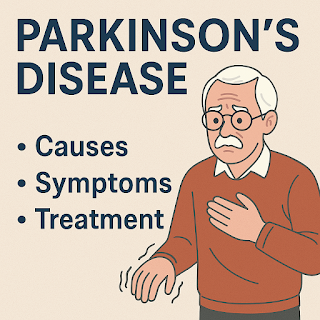Parkinson's Disease: A Comprehensive Guide to Symptoms, Causes, Diagnosis, and Management
Parkinson's disease is a progressive neurodegenerative disorder that primarily affects movement. It develops gradually, often starting with a barely noticeable tremor in one hand. While tremors are the hallmark of the disease, it also commonly causes stiffness, slow movement, and balance problems. Understanding Parkinson's disease is crucial for early diagnosis and management.
Table of Contents
What is Parkinson's Disease?
Symptoms of Parkinson's Disease
Causes and Risk Factors
Stages of Parkinson's Disease
Diagnosis
Treatment Options
Lifestyle and Home Remedies
Diet and Exercise Tips
Recommended Products (Affiliate Links)
Conclusion
1. What is Parkinson's Disease?
Parkinson's disease (PD) is a chronic and progressive disorder that affects the nervous system and the parts of the body controlled by the nerves. It is characterized by the degeneration of dopamine-producing neurons in a specific area of the brain known as the substantia nigra.
Key Facts:
Parkinson's disease affects more than 10 million people worldwide.
Symptoms typically develop after age 60 but can start earlier.
It is not directly life-threatening, but complications can be serious.
2. Symptoms of Parkinson's Disease
Motor Symptoms:
Tremors, usually starting in the hands or fingers.
Bradykinesia (slowness of movement).
Muscle stiffness.
Impaired balance and posture.
Non-Motor Symptoms:
Depression and anxiety.
Sleep disturbances.
Fatigue.
Memory problems.
Constipation.
Early detection of these symptoms can improve disease management and quality of life.
3. Causes and Risk Factors
Causes:
Loss of dopamine-producing neurons.
Genetic mutations (in some cases).
Risk Factors:
Age (over 60 years).
Family history.
Male gender.
Exposure to toxins (pesticides, herbicides).
4. Stages of Parkinson's Disease
Stage One: Mild symptoms with little to no functional impairment.
Stage Two: Symptoms worsen, affecting both sides of the body.
Stage Three: Balance issues become noticeable, increasing fall risk.
Stage Four: Severe disability; assistance required for most activities.
Stage Five: Advanced stage with wheelchair dependence or bedridden.
5. Diagnosis
There is no specific test for Parkinson's disease. Diagnosis is based on:
Medical history.
Neurological examination.
Response to Parkinson's medications.
Doctors may use imaging tests like MRI or PET scans to rule out other conditions.
6. Treatment Options
Medications:
Levodopa-Carbidopa: The most effective treatment to replenish dopamine.
Dopamine Agonists: Mimic dopamine effects.
MAO-B Inhibitors: Help prevent dopamine breakdown.
Surgical Treatments:
Deep Brain Stimulation (DBS): An implantable device that sends electrical pulses to the brain.
Therapies:
Physical therapy.
Occupational therapy.
Speech therapy.
7. Lifestyle and Home Remedies
Regular exercise to maintain flexibility and balance.
Yoga and Tai Chi for coordination improvement.
Healthy diet rich in fiber and antioxidants.
Stress management techniques like meditation.
8. Diet and Exercise Tips
Best Foods:
Fresh fruits and vegetables.
Whole grains.
Omega-3 rich foods (like salmon and flaxseeds).
Exercises:
Walking.
Stretching routines.
Balance exercises.
Maintaining a healthy lifestyle can significantly slow disease progression.
9. Recommended Products (Affiliate Links)
Supportive products can improve daily living for people with Parkinson's disease:
Note: As an Amazon Associate, I earn from qualifying purchases.
10. Conclusion
Parkinson's disease is a life-changing diagnosis, but with the right treatment, support, and lifestyle adjustments, many people can lead fulfilling lives. Early intervention and a positive approach to management can make a significant difference.
If you or a loved one is experiencing symptoms, consult a healthcare professional promptly.
Disclaimer: This article is for informational purposes only and is not a substitute for professional medical advice.


Post a Comment